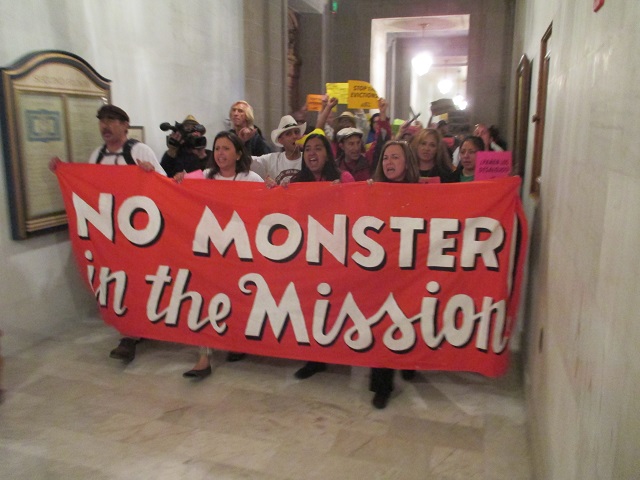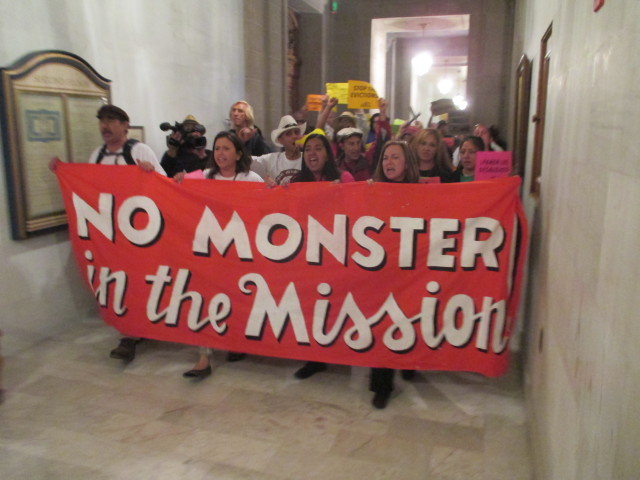
Mayor London Breed is pushing legislation that would amend the city’s historic office-space limitation law to allow an additional 1.5 million square feet of space – enough to house 6,000 more workers – with no plans for how to house those people.
This is the latest chapter in an ongoing saga in San Francisco: In the name of creating jobs, the city allows developers to build new office space, and gives tax breaks for companies to move into town – with no regard for the housing crisis that those policies create.

In this case, the legislation is a bit technical, and involves a revision to Proposition M, which in 1986 limited new office construction to 950,000 square feet a year. The tech industry is demanding more office space, and the mayor has a loophole.
The concept: For various reasons, about 1.5 million square feet of office space was converted to another use between 1984 and 2016. The Breed proposal would exempt that total from the amount the city is allowed to build.
John Elberling, director of TODCO, sent a letter to the committee pointing out the problems:
The additional space would result in about 6,000 new office workers – creating an additional housing demand for about 4,000 households, almost half of which would be moderate/middle-income employees who today cannot afford market-rate housing in San Francisco and the Bay Area.
Where will those needed extra 4,000 housing units be built? Where/how will that needed 2000 additional affordable housing units be built? There is no plan, none at all!
And suggestions that many of these new workers will live outside of San Francisco, so they are not “our problem,” is preposterous. The rest of the Bay Area’s housing development is not even close to keeping up with its economic growth either, and the shortfall in regional affordable housing development in particular is catastrophic.
More: The current fees that developers pay for jobs-housing linkage are ten years old and way too low. The current fee is $26.95 per square foot.
There is currently a total of about 6 million square feet of San Francisco office development awaiting approval … At the current rate, those projects combined will pay about $160 million of JHLP fees for new affordable housing, only enough to fund building about 500 affordable units. Even doubling this fee would bring that … total up to 1,000 units, when 2,000 more are needed just to meet the additional demand from the proposed Prop. M office developer giveaway.
So why is this happening? Well, the 950,000 square foot limit rolls over every year, so if that much space isn’t built, there’s room for more in the future. In the Great Recession, not much was constructed, so there’s been a pretty good inventory of allowable space.
But it’s now down to a total of 3.5 million square feet, and developers have about 6 million square feet of projects pending.
And no matter what they say, the real top priority of the Mayor’s Office and the Planning Department is “accommodating growth” – jamming through more tech industry office development – NOT fighting the gentrification of our communities by building all the affordable housing this growth demands.”
The measure will be considered at the Land Use and Transportation Committee Monday/29.
The Eastern Neighborhoods Plan will be on trial once again Tuesday/30. The plan, approved ten years ago, is way, way out of date– in fact, the environmental impact report on the plan assumed that between 2008 and 2025, the Mission would see 2,054 new housing units. More housing than that has already been approved.
The latest challenge involves a project at 2750 19thSt. The proposal calls for demolishing three industrial buildings on the site and building 60 residential units over 10,000 square feet of production, distribution, and repair space.
(I worked for years in that neighborhood. I started at the Bay Guardian when it was in the building next door, at 2700 19thSt. One of the things we learned was that PDR space – if it’s actually PDR space with blue-collar jobs – doesn’t mix well with luxury housing, which is what this plan involves. PDR is noisy, involves deliveries at all hours – and tends to offend rich people who live upstairs. I don’t see how this project will work.)
But the appellants are raising a larger issue. These regional planning processes allow one single environmental impact report, and then exempt any project that conforms to the area plan from an individual EIR. That’s become a huge problem.
Larisa Pedroncelli and Kelly Hill, representing Our Mission No Eviction, say the new project exceeds the discussion of the Eastern Neighborhoods EIR:
The PEIR was prepared in the midst of the the “great recession” and did not project the steep increases in housing prices that has been especially exacerbated by the increase in high paying jobs that have come to San Francisco. As a result, development has accelerated at a faster pace than anticipated by the PEIR. Major unforeseen development projects in the Eastern Neighborhoods such as the UCSF Hospital buildout, Pier 70 buildout, 5M project, Mission Bay buildout, Warriors Stadium, and the new Central SOMA plan bringing with it significant – and unanticipated – new office space to the area.
The PEIR did not anticipate the impact of tech shuttles from a traffic standpoint but also from the perspective of demand for housing in proximity to these new shuttle stops. The desire by high-earning tech employees to move to areas within a few blocks of a free ride to work has exacerbated the already high demand for housing. These shuttle stops are disproportionately in the Mission. The Anti-Eviction Mapping Project has documented the connection between shuttle stops and higher incidences of no-fault evictions.
Gentrification Has Caused Unanticipated Increases in Traffic and Automobile Ownership. The unanticipated influx of high earners in the Mission has resulted and will continue to result in a substantial increase in the rate of automobile ownership and TNC use in the Mission. It is now well recognized that high earners are twice as likely to own an automobile than their low income counterparts, even in transit rich areas such as the Mission. The TNC “ride-share” phenomena, increased frequency of amazon/meal/grocery deliveries and the implementation of Mission St “red lanes” have resulted in significantly changed traffic patterns. Additionally, the rise in “displacement commutes” of Mission families driving back long distances to their jobs and children’s schools in San Francisco, as well as the plethora of new Silicon Valley “reverse commutes” were not anticipated and have significantly changed the traffic picture. A recent INRIX Global Traffic Scorecard shows that in 2017 San Francisco driving now ranked 5th most congested city in the world, with its average driver spending 79 hours a year stuck in traffic at a cost of $10.6 billion per year (http://inrix.com/press-releases/scorecard-2017/). Although a traffic study was done for this project, it did not contain any cumulative analysis and based its Mode Share Projections on 2011-2014 projections. We cannot know the exact issues related to cumulative impacts on traffic and circulation because they have not been studied.
Reality: The supes almost never overturn planning decision and side with these appeals. But the issues that will come up are profound, and need to be addressed.
The Monster in the Mission is back.
The massive market-rate housing development at 16thand Mission, which has been the focus of community opposition for years, at one point seemed to be dead when the property owners and the developer – Maximus, which also owns ParkMerced where there are serious labor issues– couldn’t reach a deal.
But the plan is once again on the agenda of the Planning Commission, which will hold a special meeting Thursday/1 in the Mission High School Auditorium to hear an informational presentation on the latest version of the project. (UPDATE: THE HEARING HAS BEEN CANCELLED DUE TO SCHEDULING CONFLICTS, WE’LL UPDATE WHEN IT HAS BEEN RESCHEDULED.)
The current plan is for 331 mostly luxury units in a building that could reach 105 feet tall on the northeast corner of the 16thSt. BART plaza.
The issue that opponents have raised is clear: If you put hundreds of new rich residents in what has been traditionally a fairly affordable area, rents in other buildings will rise, community businesses will be forced out, and you’ll see what some have called a “gentrification bomb.”
The commission will hear from the community starting at 4pm.

